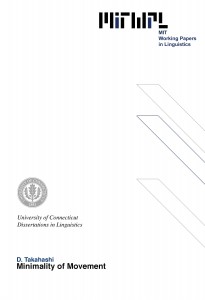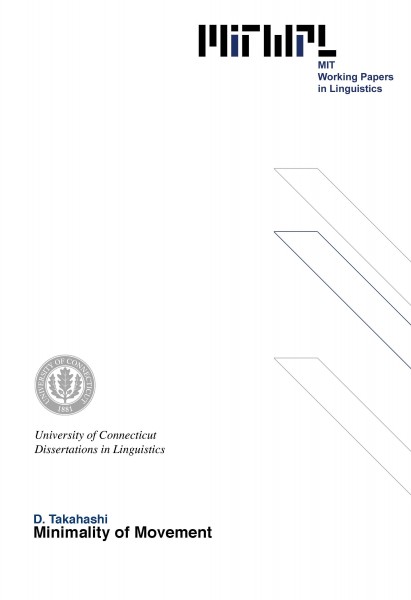Minimality of Movement
D. Takahashi, 1995
Within the framework of the principles and parameters approach to linguistic theory, this study explores consequences of the requirement that movement be shortest (the Shortest Movement Condition or SMC). It is demonstrated that the SMC, in combination with other independently necessary assumptions, derives the effects of barriers and head government, making them superfluous and thus eliminable.
The theory of adjunction plays an important role in elimination of barriers. This study proposes that adjunction not be permitted to a member of a group that respects uniformity, such as a nontrivial chain and a coordination. From this uniformity condition it follows that adjunction is disallowed to subjects in languages where they are obligatorily raised out of VP, and to adjuncts given that adjuncts involve coordination. These results receive empirical support from a number of languages.
The SMC, in conjunction with the uniformity condition on adjunction, has an effect of prohibiting extraction out of subjects and adjuncts: Such extraction must pass over positions adjoined to subjects and adjuncts and thus necessarily fails to make the shortest movement. Since this explains the effects of the Subject Condition and the Adjunct Condition without recourse to barriers, it makes barriers superfluous.
The SMC has a further consequence of deriving the complementizer trace effect, if combined with the independently motivated assumption that adjunction to IP is impermissible from the specifier of IP: Movement from the specifier of IP must skip the position adjoined to IP, so that such movement cannot be shortest. The absence of the complementizer-trace effect in cases where the complementizer is null is predicted if those cases involve movement of Infl to Comp, which makes the specifier of Comp and the IP-adjoined position equidistant from the specifier of IP so that the IP-adjoined position may be skipped. This approach receives empirical support from various languages, and is shown to be superior to a previous analysis based on the notion of head government.
Chapter 1 Introduction 1
Chapter 2 Adjunction and Uniformity 20
2.1. The Uniformity Corollary on Adjunction 21
2.2. Substitution for Specifiers as Adjunction 26
2.3. Adjunction to Subjects 27
2.4. Adjunction to Adjuncts 35
Chapter 3 Make the Shortest Movement 48
3.1. The Mechanics 48
3.2. A'-Movement 52
3.3. A-Movement 87
3.4. A Surprising Argument-Adjunct Asymmetry 98
Appendix On Improper Movement 111
Chapter 4 The Comp-Trace Effect 117
4.1. An SMC Analysis 117
4.2. West Flemish Complementizer Agreement 129
4.3. Global Equidistance 137
Bibliography 144

